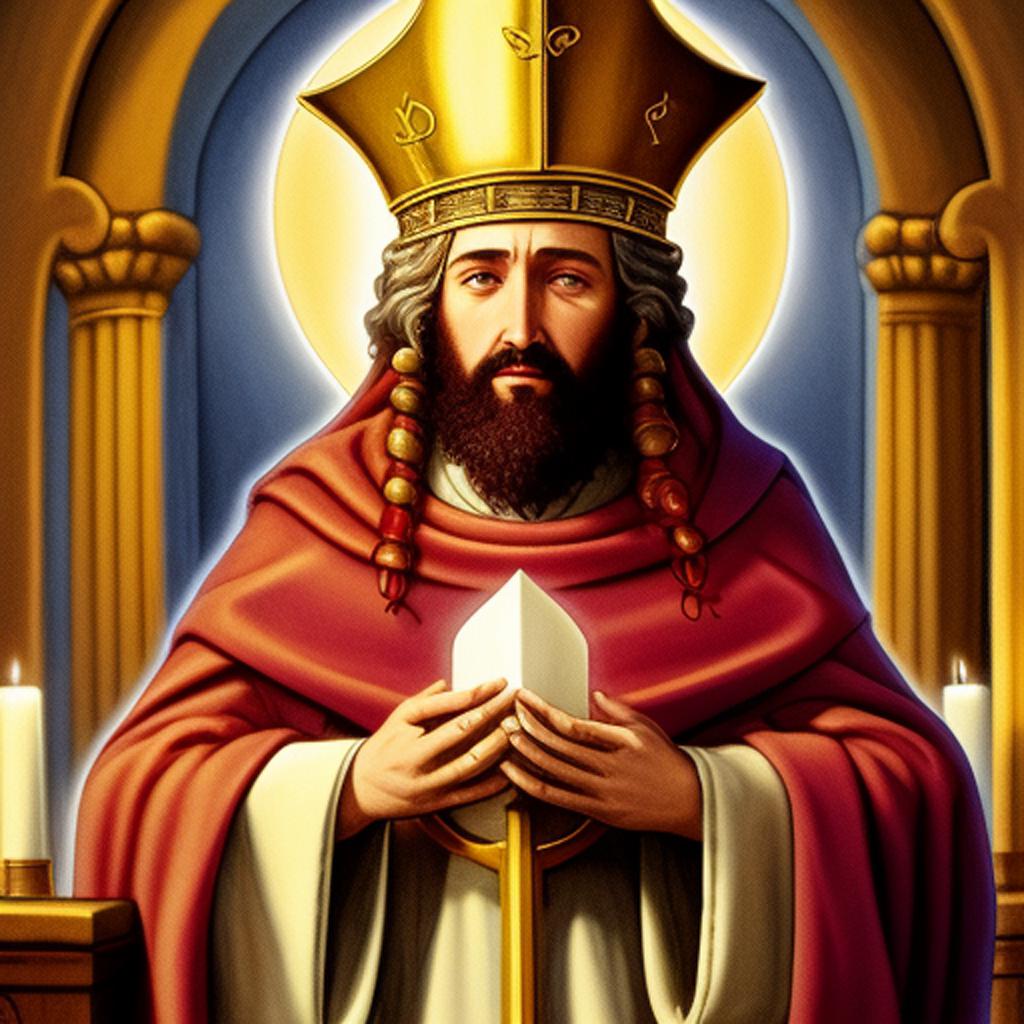Unveiling the Connection between Exodus 39, Jesus, and Messianic Prophecy
Understanding Messianic Prophecy
Messianic Prophecy is a belief held by both Jews and Christians, which involves the interpretation of specific Old Testament passages as predictions about the Messiah. The Torah, the foundational text of Judaism, plays a vital role in understanding Messianic Prophecy. It provides the context and framework for interpreting and recognizing the prophecies related to the Messiah. The primary keywords, Exodus 36, Jesus, Torah, and Messianic Prophecy, are key elements in exploring the relationship between Exodus 39 and Messianic Prophecy.
The concept of Messianic Prophecy is deeply rooted in Jewish tradition. The Jewish people have long awaited the coming of the Messiah, who is believed to bring redemption and restore the Kingdom of God on earth. The Torah, consisting of the first five books of the Old Testament, contains numerous passages that are seen as foreshadowing the coming of the Messiah. These passages often use symbolic language and imagery, making them open to interpretation. Jewish scholars and sages have debated the meaning of these prophecies for centuries, seeking to unravel their hidden messages.
For Christians, Messianic Prophecy takes on a different significance. They believe that Jesus of Nazareth fulfilled these prophecies and is the long-awaited Messiah. Christians interpret the Old Testament passages in light of the life, death, and resurrection of Jesus, finding fulfillment in his teachings and actions. The New Testament, particularly the Gospels, serves as a guide for understanding the connection between the prophecies and the life of Jesus. Through Jesus, Christians believe that the Messianic prophecies have been brought to completion, ushering in a new era of salvation and redemption.
The Torah, as the foundational text of Judaism, provides the basis for understanding Messianic Prophecy. It contains the laws, narratives, and prophecies that shape Jewish beliefs and practices. The Torah serves as a guide for interpreting and recognizing the prophecies related to the Messiah. Jewish scholars use various interpretive methods, such as Midrash and Kabbalah, to uncover the hidden meanings of the prophecies. These methods involve delving into the historical, cultural, and linguistic aspects of the Torah to gain insights into the nature of Messianic Prophecy.
For Christians, the Torah plays a significant role in understanding the fulfillment of Messianic Prophecy in Jesus. Jesus himself acknowledged the importance of the Torah, stating that he came not to abolish the Law but to fulfill it. Christians interpret the prophecies within the context of the Torah’s teachings, recognizing Jesus as the ultimate fulfillment of the covenant relationship between God and humanity. The Torah provides the foundation for understanding the significance of Jesus’ life, death, and resurrection, as well as the implications of his messianic identity.
The Garments of the Priests in Exodus 39
Exodus 39 provides a detailed account of the making of the priest’s garments, including the ephod, breastplate, and robe of the ephod, among others, as outlined in the instructions given by God. These garments were not only rich and splendid but also held symbolic significance, serving as shadows of the grace of the gospel. They were patterned for the work of the priests, assisting people in finding God’s direction for their lives. Their value and distinctiveness set the priests apart in their role, representing their ministry and responsibilities. The workers followed God’s instructions precisely, and Moses inspected their work, finding that everything was done according to God’s guidance.
The priestly garments described in Exodus 39 were designed to reflect the holiness and purity required for the priestly role. Each element of the garments, from the fine linen fabric to the intricate embroidery and precious stones, held symbolic meaning. For example, the ephod, a sleeveless garment worn over the robe, was adorned with two onyx stones on the shoulders, each engraved with the names of six tribes of Israel. This signified the priest’s role as a representative of the people, bearing their burdens and interceding on their behalf before God.
The breastplate, with twelve precious stones representing the twelve tribes of Israel, further emphasized the priest’s role as a mediator between God and the people. The Urim and Thummim, two stones placed within the breastplate, were believed to aid in receiving divine guidance and wisdom. The robe of the ephod, woven entirely of blue, symbolized the heavenly nature of the priestly office. Each element of the priestly garments served to remind the people of their covenant relationship with God and the importance of the priestly mediation in their worship and spiritual journey.
The priestly garments described in Exodus 39 are significant not only for their symbolism but also for their historical accuracy. Archaeological discoveries have provided further evidence for the existence of such garments and their use in ancient Israelite worship. For example, the discovery of the Tel Dan Stele, an ancient stone inscription, mentions the “House of David,” confirming the existence of the Davidic dynasty, which is closely tied to the role of the High Priest. These archaeological findings provide additional support for the historical accuracy of the priestly garments described in Exodus 39.
Jesus as the Fulfillment of Messianic Prophecy
Christians believe that Jesus fulfilled the Messianic Prophecy, with specific Old Testament passages serving as evidence of his role as the Messiah. Prophecies such as his birth in Bethlehem, virgin birth, miracles, death for the sins of others, and resurrection are seen as fulfilled in Jesus. However, it is important to note that many of these prophecies were not initially recognized as messianic by Jews before Christians interpreted them as such. The interpretation of Old Testament passages as predictions of Jesus arose from the belief that he fulfilled the Scriptures. It is worth mentioning that some passages in Isaiah, often cited as messianic prophecies, do not explicitly mention the Messiah.
The fulfillment of Messianic Prophecy in Jesus is a cornerstone of Christian theology. The Gospels, particularly the Gospel of Matthew, highlight the connections between Jesus and the Old Testament prophecies. Matthew often quotes or alludes to these prophecies to demonstrate how Jesus’ life and ministry fulfill the expectations of the Messiah. For example, Matthew cites the prophecy in Micah 5:2, which predicts the birth of the Messiah in Bethlehem, as evidence of Jesus’ messianic identity. Similarly, the Gospel of Luke emphasizes the prophetic significance of Jesus’ birth through the story of the shepherds and the angelic proclamation.
The interpretation of Messianic Prophecy in Christianity has been a subject of debate and discussion throughout history. Different scholars and theologians have offered various perspectives on the specific prophecies and their fulfillment in Jesus. Some have sought to find direct correspondences between the Old Testament passages and the events of Jesus’ life, while others have emphasized the typological connections and overarching themes. Regardless of the specific interpretive approach, the belief in Jesus as the fulfillment of Messianic Prophecy remains a central aspect of Christian faith.
The Significance of the Torah in Understanding Messianic Prophecy
The Torah plays a crucial role in interpreting and understanding Messianic Prophecy, providing the foundation for recognizing and comprehending the prophecies. The Torah shapes the beliefs and expectations of both Jews and Christians regarding the coming of the Messiah. Understanding the Torah is essential for grasping the historical and cultural context in which Messianic Prophecy was formed.
The Torah, often referred to as the Law, contains the foundational teachings and commandments of Judaism. It encompasses the first five books of the Old Testament: Genesis, Exodus, Leviticus, Numbers, and Deuteronomy. These books provide the historical and theological framework for the Jewish faith, outlining the covenant relationship between God and the people of Israel. The Torah is filled with narratives, laws, and prophecies that shape Jewish beliefs and practices.
In the context of Messianic Prophecy, the Torah serves as a guide for interpreting the prophecies related to the Messiah. It establishes the expectations and criteria for recognizing the coming of the Messiah. The Torah contains promises and predictions concerning the future Redeemer, offering glimpses of the Messiah’s role and mission. By studying the Torah, both Jews and Christians gain insights into the nature of Messianic Prophecy and its connection to the person of Jesus.
Jewish scholars and rabbis have dedicated extensive efforts to the study of the Torah and its Messianic implications. They have developed various interpretive methods and frameworks to uncover the hidden meanings of the prophecies. These methods include traditional approaches such as Midrash, which involves filling in gaps in the text through creative interpretation, and Kabbalah, which delves into the mystical dimensions of the Torah. Through their engagement with the Torah, Jews seek to deepen their understanding of Messianic Prophecy and its relevance to their faith.
For Christians, the Torah provides a rich backdrop for understanding the fulfillment of Messianic Prophecy in Jesus. Jesus himself acknowledged the significance of the Torah, stating that he came not to abolish the Law but to fulfill it. Christians interpret the prophecies within the context of the Torah’s teachings, recognizing Jesus as the ultimate fulfillment of the covenant relationship between God and humanity. The Torah provides the foundation for understanding the significance of Jesus’ life, death, and resurrection, as well as the implications of his messianic identity.
The Views of Jews and Christians on Messianic Prophecy
Jews and Christians have different interpretations of Messianic Prophecy, leading to divergent views on Jesus as the Messiah. Most Jews reject the claim that Jesus was the Messiah, and they do not interpret the Old Testament passages in the same way as Christians. Christians base their belief in Jesus fulfilling Old Testament predictions on the accounts of his life in the Gospels, which they believe were influenced by the Messianic Prophecy. The rejection of Jesus as the Messiah by many Jews is a significant reason for the divergence between the two perspectives.
In Judaism, Messianic Prophecy is understood as a vision of a future age of peace and righteousness. The Messiah is anticipated as a human descendant of King David who will restore the Davidic dynasty and establish a reign of justice and harmony. The focus is on the earthly realm and the fulfillment of the promises made to the people of Israel. Jewish interpretations of the prophecies emphasize the collective redemption of the Jewish people and the restoration of the land of Israel.
For Christians, Messianic Prophecy is seen in the light of Jesus’ life, death, and resurrection. They believe that Jesus is the fulfillment of the promises made in the Old Testament and that he brings salvation not only to the Jewish people but to all humanity. Christians interpret the prophecies as pointing to Jesus’ role as the Savior and the establishment of God’s Kingdom both in this world and the next. The focus is on the spiritual redemption and eternal life offered through faith in Jesus.
The divergent views between Jews and Christians on Messianic Prophecy reflect the different theological and interpretive frameworks within each tradition. While both groups hold the Scriptures as sacred and consider the prophecies significant, their understandings of the Messiah and the fulfillment of the prophecies diverge. These differences have shaped the religious identities and beliefs of Jews and Christians throughout history.
Examining the Facts: Historical Accuracy and Interpretation
The historical accuracy of certain events related to Jesus and Messianic Prophecy has been a subject of debate. The birth of Jesus in Bethlehem, often considered a fulfillment of prophecy, lacks strong historical support, and the Gospels present inconsistent accounts to align with the Old Testament prophecy. Some alleged messianic prophecies either were not predictions of the future Messiah or the supposed facts of Jesus’ life that fulfilled these prophecies are not historically accurate. The crucifixion of Jesus posed a challenge for Jews, as it contradicted their understanding of what the Messiah would do. These historical and interpretational challenges surrounding Messianic Prophecy contribute to the differences in belief between Jews and Christians.
Historical inquiries into the life of Jesus and the fulfillment of Messianic Prophecy have sought to establish the reliability of the biblical accounts and the accuracy of the prophecies. Scholars have examined various sources, including archaeological evidence, ancient texts, and historical records, in their quest for a comprehensive understanding of the historical Jesus.
One of the challenges in assessing the historical accuracy of the fulfillment of Messianic Prophecy is the nature of the prophecies themselves. Many of the prophecies are open to interpretation and can be understood in different ways. This ambiguity leaves room for differing opinions on whether certain events in Jesus’ life fulfilled the prophecies. For example, the prophecy in Isaiah 7:14, which speaks of a virgin giving birth, has been interpreted by Christians as being fulfilled in Jesus’ birth to the Virgin Mary. However, Jewish scholars argue that the Hebrew word used in the original text refers to a young woman rather than a virgin, leading to a difference in interpretation.
Another aspect of historical accuracy revolves around the crucifixion of Jesus. In Jewish tradition, the Messiah is expected to be a victorious king who will liberate the Jewish people from oppression, not a suffering servant who dies on a cross. This discrepancy between expectations and the events of Jesus’ crucifixion has led many Jews to reject him as the Messiah. The interpretation of Messianic Prophecy requires careful consideration of historical context, cultural expectations, and the complexities involved in reconciling the biblical accounts with historical evidence.
While historical research can shed light on certain aspects of Messianic Prophecy, it is important to recognize that faith plays a significant role in both Jewish and Christian interpretations. The belief in the divine inspiration of the Scriptures and the fulfillment of prophecy in Jesus goes beyond historical analysis. Ultimately, the interpretation and understanding of Messianic Prophecy are deeply intertwined with religious faith and theological convictions.
Jesus as the High Priest in the Heavenly Sanctuary
According to Christian belief, Jesus serves as the High Priest in the heavenly sanctuary. His role as the ultimate High Priest is seen as the fulfillment of the priestly function outlined in Exodus 39. Jesus intercedes for sinners and bears their names, just as the ephod with the twelve stones on Aaron’s breast represented bearing the names of the children of Israel. By fixing our eyes on Jesus, believers find assurance that he ministers in the heavenly sanctuary and will never forget them.
The concept of Jesus as the High Priest draws on the imagery and symbolism of the priestly garments described in Exodus 39. The ephod, breastplate, and other priestly garments served as a visual reminder of the priest’s role as a mediator between God and the people. In the New Testament, Jesus is portrayed as the perfect and eternal High Priest, who offers himself as a sacrifice for the forgiveness of sins. This understanding is particularly emphasized in the Book of Hebrews, where Jesus is described as the “great high priest” who has passed through the heavens and made atonement for humanity.
The role of Jesus as the High Priest is significant for Christians, as it underscores the central theme of redemption and salvation. Through his sacrificial death on the cross, Jesus bridged the gap between humanity and God, offering forgiveness and reconciliation. His role as the High Priest in the heavenly sanctuary ensures that believers have access to God’s grace and mercy. By fixing their eyes on Jesus, believers find comfort and assurance that he continues to intercede on their behalf and advocate for their salvation.
The connection between Exodus 39, Jesus, and Messianic Prophecy highlights the continuity and fulfillment of the priestly function in the person of Jesus. Just as the priestly garments in Exodus 39 represented the unique role and responsibilities of the priests, Jesus’ role as the High Priest signifies his divine mission to reconcile humanity with God. The priestly garments served as a visible reminder of God’s presence and grace, and Jesus, as the High Priest, provides believers with the assurance of God’s love and forgiveness.
Conclusion: Unveiling the Connection between Exodus 39, Jesus, and Messianic Prophecy
The connection between Exodus 39, Jesus, and Messianic Prophecy sheds light on the significance of the priestly garments, the fulfillment of prophecy in Jesus, and the role of the Torah in understanding Messianic Prophecy. Understanding the perspectives of both Jews and Christians on Messianic Prophecy provides insights into the divergent beliefs and interpretations regarding Jesus as the Messiah. Exploring the historical accuracy and interpretation of Messianic Prophecy deepens our understanding of the challenges and debates surrounding this topic. Recognizing Jesus as the High Priest in the heavenly sanctuary completes the connection between Exodus 39, Jesus, and Messianic Prophecy, emphasizing his role as the ultimate fulfillment of the priestly function.
The priestly garments described in Exodus 39 hold symbolic significance and serve as a visual representation of the grace of the gospel. They remind believers of the priestly role of Jesus, who intercedes for sinners and bears their names. The fulfillment of Messianic Prophecy in Jesus is a foundational belief for Christians, as it affirms their faith in Jesus as the long-awaited Messiah. The Torah, with its prophecies and teachings, provides the framework for understanding the significance of Jesus’ life, death, and resurrection, as well as the implications of his messianic identity.
In conclusion, the connection between Exodus 39, Jesus, and Messianic Prophecy offers a profound insight into the fulfillment of ancient prophecies and their significance in the life of Jesus. It highlights the importance of the Torah as the foundation for understanding Messianic Prophecy and reveals the divergent views between Jews and Christians on the interpretation of these prophecies. The historical accuracy and interpretation of Messianic Prophecy pose challenges and debates, underscoring the complex nature of religious belief and theological understanding. Ultimately, recognizing Jesus as the High Priest in the heavenly sanctuary completes the connection, affirming his role as the ultimate fulfillment of the priestly function and the embodiment of God’s redemptive plan for humanity.
#Exodus39Connection #MessianicProphecy #JesusFulfillment #BiblicalInterpretation #PropheticRevelation #FaithAndBelief #BiblicalSymbolism #RedemptiveNarrative #ReligiousUnderstanding #DivineFulfillment #TorahExploration #OldTestamentRelevance #NewTestamentLink #ChristianTheology #FaithJourney #ReligiousScholarship #MessiahInExodus #SpiritualInsights #BiblicalExegesis #MessiahRevealed


